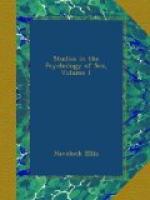[355] In the northern territory of the same colony menstruation is said to be due to a bandicoot scratching the vagina and causing blood to flow (Journal of the Anthropological Institute, p. 177, November, 1894). At Glenelg, and near Portland, in Victoria, the head of a snake was inserted into a virgin’s vagina, when not considered large enough for intercourse (Brough Smyth, Aborigines of Victoria, vol. ii, p. 319).
[356] Frazer, Golden Bough, vol. ii, p. 231. Crawley (The Mystic Rose, p. 192) also brings together various cases of primitive peoples who believe the bite of a snake to be the cause of menstruation.
[357] Meyners d’Estrez, “Etude ethnographique sur le lezard chez les peuples malais et polynesiens,” L’Anthropologie, 1892; see also, as regards the lizard in Samoan folk-lore, Globus, vol. lxxiv, No. 16.
[358] Journal Anthropological Society of Bombay, 1890, p. 589.
[359] Boudin (Etude Anthropologique: Culte du Serpent, Paris, 1864, pp. 66-70) brings forward examples of this aspect of snake-worship.
[360] Attilio de Marchi, Il Culto privato di Roma, p. 74. The association of the power of generation with a god in the form of a serpent is, indeed, common; see, e.g. Sir W.M. Ramsay, Cities of Phrygia, vol. i, p. 94.
[361] It is noteworthy that one of the names for the penis used by the Swahili women of German East Africa, in a kind of private language of their own, is “the snake” (Zache, Zeitschrift fuer Ethnologie, p. 73, 1899). It may be added that Maeder ("Interpretation de Quelques Reves,” Archives de Psychologie, April, 1907) brings forward various items of folk-lore showing the phallic significance of the serpent, as well as evidence indicating that, in the dreams of women of to-day, the snake sometimes has a sexual significance.
[362] W.R. Smith, Kinship and Marriage in Early Arabia, 1885, p. 307. The point is elaborated in the same author’s Religion of Semites, second edition, Appendix on “Holiness, Uncleanness, and Taboo,” pp. 446-54. See also Wellhausen, Reste Arabischen Heidentums, second edition, pp. 167-77. Even to the early Arabians, Wellhausen remarks (p. 168), “clean” meant “profane and allowed,” while “unclean” meant “sacred and forbidden.” It was the same, as Jastrow remarks (Religion of Babylonia, p. 662), among the Babylonian Semites.
[363] J.C. Frazer, The Golden Bough, Chapter IV.
[364] E. Durkheim, “La Prohibition de l’Inceste et ses Origines,” L’Annee Sociologique, Premiere Annee, 1898, esp. pp. 44, 46-47, 48, 50-57. Crawley (Mystic Rose, p. 212) opposes Durkheim’s view as to the significance of blood in relation to the attitude towards women.
[365] British Association Report on North Western Tribes of Canada, 1890, p. 581.
[366] Laws of Manu, iv, 41.




